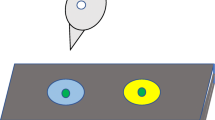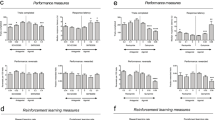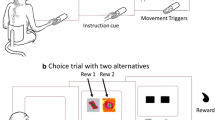Abstract
Low doses of amphetamine induce choice perseveration in an object discrimination task under conditions where such perseveration either increases or decreases the number of rewards obtained as compared to chance performance. Neither stereotyped motor actions nor repetitive choice of position contributed to this effect which could be blocked by pre-treatment with the neuroleptic haloperidol. These results demonstrate that higher order choice mechanisms may involve dopamine systems in the primate.
Similar content being viewed by others
References
Alexander M, Isaac W (1965) Effect of illumination on the activity of the rhesus macaque. Psychol Rep 16:311–315
Connell PH (1958) Amphetamine psychosis. Maudsley Monogr 5
Crow TJ (1970) Enhancement by cocaine of intracranial self-stimulation in the rat. Life Sci 9:375–381
Ellinwood Jr EH, Kilbey MM (1975) Amphetamine stereotypy: The influence of environmental factors and prepotent behavioural patterns on its topography and development. Biol Psychiatry 10:3–16
Gellermann LW (1933) Chance orders of alternating stimuli in visual discrimination experiments. J Genet Psychol 42:206–208
Harlow HF (1958) Behavioral contributions to interdisciplinary research. In: Harlow HF, Woolsey CN (eds) Biological and biochemical bases of behavior. Madison: University of Wisconsin, p 3
Hill RT (1970) Facilitation of conditional reinforcement as a mechanism of psychomotor stimulation. In: Costa E, Garattini S. (eds) Amphetamines and related compounds. Raven, New York, p 781
Isaac W, Troelstrup R (1969) Opposite effect of illumination and d-amphetamine upon activity in the squirrel monkey (Saimiri) and the owl monkey (Aotes). Psychopharmacologia 15:260–264
Kallman WM, Isaac W (1975) The effects of age and illumination on the dose-response curve for three stimulants. Psychopharmacologia 40:313–318
Ljundberg T, Ungerstedt U (1978) Classification of neuroleptic drugs according to their ability to inhibit apomorphine induced gnawing and locomotion: Evidence for principally different mechanisms of actions. Psychopharmacology 56:239–247
Lyon M, Robbins T (1975) The action of central nervous system stimulant drugs: A general theory concerning amphetamine effects. Curr Dev Psychopharmacol 2:80–163
Nielson IM, Pedersen V, Nymark M, Franck KF, Boecke V, Fjalland B, Christensen AV (1973) The comparative pharmacology of flupenthixol and some reference neuroleptics. Acta Pharmacol Toxicol (Kbh) 33:353–362
Peroutka SJ, U'Pritchard DC, Greenberg DA, Snyder SH (1977) Neuroleptic drug interactions with norepinephrine alpha receptor binding sites in rat brain. Neuropharmacology 16:549–556
Randrup A, Munkvad I (1967) Stereotyped activities produced by amphetamine in several animal species and man. Psychopharmacologia 11:300–310
Rapoport J, Buchsbaum M, Zahn TP, Weingartner H, Ludlow C, Mikkelsen EJ (1978) Dextroamphetamine: Cognitive and behavioural effects in normal prepubertal boys. Science 199:560–563
Ridley RM, Baker HF, Scraggs PR (1979) The time course of the behavioural effects of amphetamine and their reversal by haloperidol in a primate species. Biol Psychiatry 14:753–765
Ridley RM, Baker HF, Weight ML (1980a) Amphetamine disrupts successive but not simultaneous visual discrimination in the monkey. Psychopharmacology 67:241–244
Ridley RM, Weight ML, Haystead TAJ, Baker HF (1980b) ‘Go here-go there’ performance after amphetamine: The importance of the response requirement in successive discrimination. Psychopharmacology 69:271–273
Robbins TW, Sahakian BJ (1979) ‘Paradoxical’ effects of psychomotor stimulant drugs in hyperactive children from the standpoint of behavioural pharmacology. Neuropharmacology 18:931–950
Rylander G (1971) Stereotype behaviour in man following amphetamine amine abuse. In: Baker SD de C (ed) The correlation of adverse effects in man with observations in animals. Excerpta Medica International Congress Series 220. Amsterdam, p 28
Scraggs PR, Ridley RM (1978) Behavioural effects of amphetamine in a small primate: Relative potencies of the d-and l-isomers. Psychopharmacology 59:243–245
Stein L (1964) Amphetamine and neural reward mechanisms. In: Steinberg H (ed) Animal behavior and drug action. Little, Brown and Co Boston, p 91
Weight ML, Ridley RM, Baker HF (1980) The effect of amphetamine on delayed response performance in the monkey. Pharmacol Biochem Behav 12:861–864
Author information
Authors and Affiliations
Rights and permissions
About this article
Cite this article
Ridley, R.M., Haystead, T.A.J. & Baker, H.F. An involvement of dopamine in higher order choice mechanisms in the monkey. Psychopharmacology 72, 173–177 (1981). https://doi.org/10.1007/BF00431652
Received:
Accepted:
Issue Date:
DOI: https://doi.org/10.1007/BF00431652




